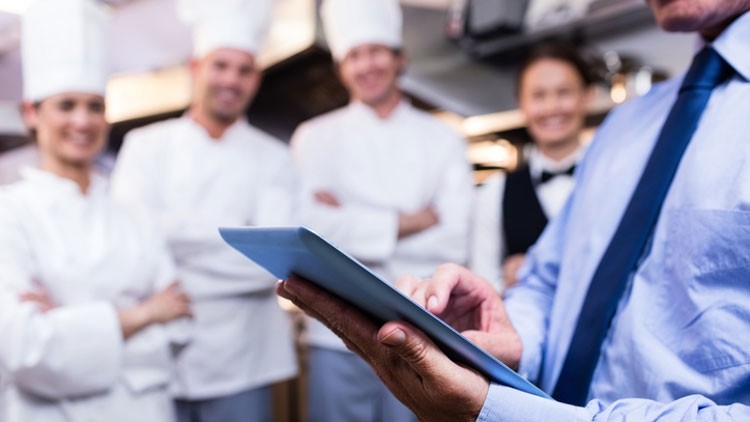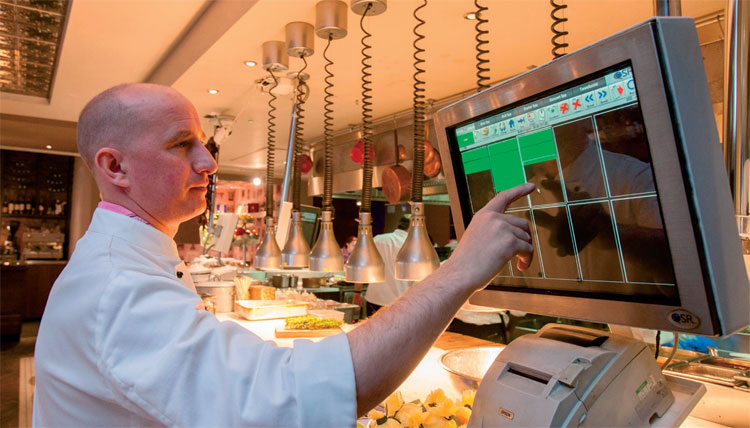Promoted Feature
Five ways to solve common kitchen bottlenecks

Getting to that objective means you must overcome the immense complexity in running a kitchen, while addressing the multitude of bottlenecks that prevent you from reaching your goal.
Bottlenecks can be big or small. Some of the simple ones can be addressed by changing your operational processes. The larger pain points that keep you up at night may take much longer to resolve. Implementing a technology solution is often the only pain reliever to solve your biggest back of house (BOH) pain points. For example, let’s say your kitchen is pumping out dishes in record time, but plates are frequently dropped by wait staff before delivery to the table. Maybe by changing your kitchen entry and exit pathway process, you can prevent unexpected shoulder or hip bumps that send plates and glasses crashing to the floor.
On the other hand, your kitchen may have larger pains in predicting when to place the next kitchen supply order or guesstimating how much supply of this ingredient or that to order. A technology solution that bases estimates on hard data may be your only answer to that problem.
Where does it hurt?
Pain points can come in all shapes and flavours — and, unlike Baskin-Robbins, they don’t stop at 31! At times, you may encounter so many pain points in your restaurant kitchen that you are left not knowing which to address first. In those instances, sorting those pain points into categorised buckets can help you determine which technology solution will ultimately ease the pain. Typically, you’ll find that despite which pain point arises, it will always fall into one of four broader categories:
● Process pain points — you need to install a loyalty system or a customer relationship management system
● Support pain points — your diners aren’t receiving the wait staff support they need in choosing the meals
● Financial pain points — you need to reduce your costs and install efficiencies to help you reach that goal
● Productivity pain points — you need to improve order accuracy to decrease customer loss
Where does it hurt your customer?
From there, you’ll want to take your kitchen bottlenecks and compare them to one’s your customers have identified as their pain points. Find the correlation between the two, and you’ll soon see which solution offers the greatest impact for improving your bottom line. If you aren’t consistently earning positive online reviews for your restaurant, start there. For a snapshot of your diners’ experience, customer surveys offer the widest lens. Better yet, place your customer surveys at the point of payment, and you’ll more quickly discover your customer’s pain points, cutting the time between awareness of problems and their possible solutions.
Using customer surveys to resolve problems is well worth the effort around prompting feedback, then collecting, and reviewing the data. Use the positive customer feedback in your market’s messaging, and use the negative feedback as a spark for improvement. To see how much of an effect those efforts can make, consider the American Express 2017 Customer Service Barometer showing that Americans tell an average of 15 people about poor service, versus the 11 people they’ll tell about a good experience. Furthermore, increasing customer retention rates by just 5% will increase profits as much as 95%, according to global management consulting firm Bain & Company.
Problems Solved
To take your restaurant from meh to marvellous, first look at your organisational pain points. Those might be real or perceived. Either way, they will remain problems until you address them. Let’s evaluate the most common pain points, many having their beginnings in the kitchen, and then let’s uncover possible solutions to each.
PROBLEM ONE: I want a stellar dining experience for my guests; I don’t know which technology will make the greatest impact.
You want to raise the bar on your guest experience but don’t know where to start. Operators know this desire often goes above and beyond the taste of a meal. Here are areas that customers often refer to when citing a stellar dining experience:
● Communication about their meal delivery
● Wait staff menu knowledge
● Menu flexibility
● Payment speed
SOLUTION
Fortunately, all of these critical areas around the dining experience can be addressed in one integrated technology solution. A robust Kitchen Display System (KDS) gives restaurant operators a complete way to solve these issues all at the same time, versus you selecting one and hoping it’s the most effective. Whether you run an independent, multi-unit, or national chain, the right KDS can turn so-so dining experiences into ones that create return customers. Choose a KDS that answers all the critical areas cited by restaurant guests and you are well on your way to your dining experience goal for your guests.
PROBLEM TWO: Our ticket times are too long.
Expectation that doesn’t meet reality is cause for concern, especially if that expectation comes from a guest at your restaurant. When that happens, heads turn in search of wait staff, restlessness ensues, and time-crunched customers become irritable. These slow ticket times create bottlenecks at the front-of-the-house (FOH) with fewer table turns, resulting in more people turning away from your restaurant due to longer than average wait times. The result: Lower dining reputation in the community and less opportunity for repeat business.
SOLUTION
Operators wanting to reduce ticket times turn to a KDS. A smart KDS solution can make a restaurant operation more successful during peak dining times, when things can quickly go from a quiet calm to chaos.
To reduce ticket times, lower table turns, and increase throughput, look for a KDS system that offers you the following:
● Customised routing options — gives your kitchen better pacing by ensuring each station need only focus on what needs to be prepared
● Graphical display — easier for highlighting special instructions often overlooked in a paper kitchen, where mistakes more frequently occur
● Customised meal pacing — ensures food is prepared for table delivery at the proper time
● Configurable metrics — gives operators real-time data to identify trends with bottlenecks and labour inefficiencies
● Activity levels — allows the kitchen to react on the fly to varied staffing changes and volume levels by providing a way to set up different displays and routing configurations
PROBLEM THREE: My tech solutions haven’t entered the digital age; they can’t share information across the restaurant system.
Operators have seen the wisdom; paper tickets have become “last century” and digital point-of-sale (POS) is now increasingly an expectation in restaurant operations. Yet with so many different POS systems, printers, guest management systems, and more, operators have a real challenge in getting all their restaurant technology on one page. Implemented technology that should have offered more restaurant efficiencies is now gumming up the works, slowing staff down, and presenting problems.
SOLUTION
Forward-thinking operators look for technology solutions with a vast number of proven integrations. These integrations should involve the technology solutions most in use today. Your guest management system and KDS should be able to be integrated with your POS system, while also being able to talk to your online and delivery provider, printer of choice, and more.
PROBLEM FOUR: I don’t have enough reliable information to make good business decisions.
What some operators and managers may not realise is that this problem is far deeper for a restaurant than the one that initially comes to mind. Yes, you need data to make good business decisions, but you also need to make those decisions more efficiently. Accurate metrics won’t do you any good if you get the data late. Having reliable and real-time data is your first criteria in finding a solution that can help steer your business in the right direction.
Trusting your gut for important decisions should not be disregarded but having the metrics to backup a gut feeling can lead to more confident decisions that can put you in front of competitors. As the top leader in your organisation, relying on incomplete and vague information is foolhardy and will contribute to higher uncertainties about your decision.
SOLUTION
A kitchen display system that captures all the data that feeds your decision is the wisest choice. Look for a system that provides you with ticket times, information on kitchen bottlenecks that need to be addressed, menu reporting, as well as labour efficiencies and inefficiencies. An integrated KDS can deliver all of your restaurant’s data points in real-time, giving you confidence that your decision is based on solid information.
PROBLEM FIVE: My kitchen can’t stay ahead of off-premise dining increases.
To reach new customers or encourage existing diners to spend more, no better way exists than through off-premise dining. Increases in carry-out and delivery orders are surpassing those for dine-in service, even though the percentages of off-premise are still relatively small. You need to address the rising increase and build your revenue stream in this area but may not know where to turn.
SOLUTION
Smart restaurant operators are creating a strategy to combine in-house and off-premise dining orders that often strain BOH operations and slow down meal delivery, inside and out. Those on the outside want convenience, speed, and an effortless process through which to place their take-out orders. Those on the inside want a smooth-running kitchen without all the guesswork in fulfilling those off-premise orders. Again, a state-of-the-art kitchen display system can reduce BOH stress while providing guests with the convenience of real-time order tracking.
Look for a kitchen display system that connects your current kitchen capacity with incoming orders. That way, your restaurant can deliver accurate order status updates direct to your customer’s mobile and online devices. Integrated KDS technology can deliver guest data for a more personal experience and ensure quality of every meal, both in the restaurant and off-premise.
Turning Problems Around
Restaurant operators face many challenges in a given day. Often ongoing problems, once solved, can lead to the greatest success. Find a flexible technology solution that provides support for a busy kitchen — a solution that gives your chefs and FOH staff more control with programmable prep times, access to real-time production information, and kitchen video. With the right solution, your toughest problems can become an organisational advantage.
































